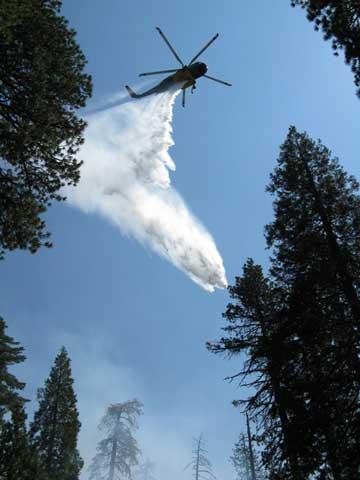The 2009 fire season is over at Yosemite National Park—at least officially—and Mother Nature ended it with a big splash.
A number of factors determine when conditions are favorable for a wildfire, but one of the most significant is the weather. Officials at Yosemite National Park declare the annual fire season to be over when "there is a season ending precipitation event totaling 2 inches or more." Historically, there is a 90% chance this will occur by October 31.
There wasn't any doubt if enough moisture had fallen this year, and it came a bit earlier than usual. According to the park,
The rainfall measurement [last week] from park weather stations varied from 9 inches of rain in the Mariposa Grove, to approximately 8 inches of rain in Wawona, to 5.5 inches of rain in Yosemite Valley. Measurable snow also fell at higher elevations.
The official declaration about the fire season doesn't mean visitors shouldn't be careful with fire between now and next summer, especially if unusually warm and dry conditions return anywhere in the area. The approach of winter does mean the park can gear down in terms of staffing and priorities for fire activities, and that includes air operations. The park notes,
Helicopter 551, Yosemite’s helicopter that is contracted for the fire season, has now left the park. Additionally, seasonal fire personnel are completing their assignments and will soon also be leaving the park.
The contract helicopter is a key part of the park's aviation program, and park visitors and other aspects of park operations also benefit from its availability.
The Yosemite National Park Aviation Program supports wildland fire suppression, prescribed fire management, search and rescue, high priority medical evacuations, and the law enforcement special response team. The aviation program also supports resources management and maintenance operations such as bear relocation, aerial transport of waste from backcountry campsites, and sling-hauling bridge beams and other construction materials not able to be packed in by stock animals.
Wildland fire is the single largest use of the helicopter in Yosemite National Park. Helicopter use allows for timely delivery of personnel to backcountry fires that in some cases would exceed a 2 day hike. Once firefighters are committed to an incident, the protection of human life is the single most overriding priority for that incident.
Setting priorities among protecting human communities and community infrastructure, other property and improvements, and natural and cultural resources will be based on the values to be protected, human health and safety, and the costs of protection. Other critical helicopter missions outside of fire include search and rescue, short haul, high angle rescue, and wilderness trails support.
Park use of aircraft is generally limited to flights necessary for fire suppression, research, administration, law enforcement, maintenance, health and safety, search and rescue, and to gain access to areas of the Park permanently or temporarily inaccessible by other means to carry out needed management activity.
Park fire managers will probably be glad to put the wraps on the 2009 season. The Big Meadows fire, the escaped prescribed burn that eventually totaled 7,425 acres, proved to be the most significant fire activity in the park this year, but historical data offers some perspective for that fire.
Prior to fire suppression by Euro-American settlers, approximately 16,000 acres burned each year in Yosemite National Park either by natural fires or through American Indian fire management practices.
If you'd like more information about the role of fire in Yosemite and about the park's fire management program, a good starting place is this link on the park website.


 Support Essential Coverage of Essential Places
Support Essential Coverage of Essential Places






